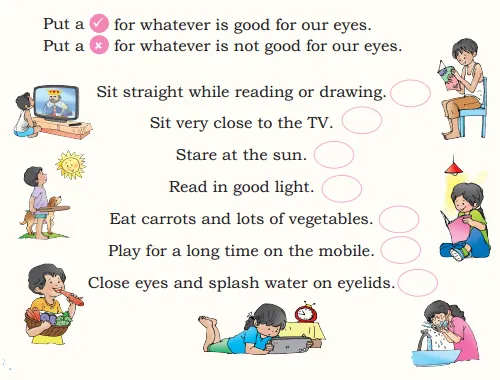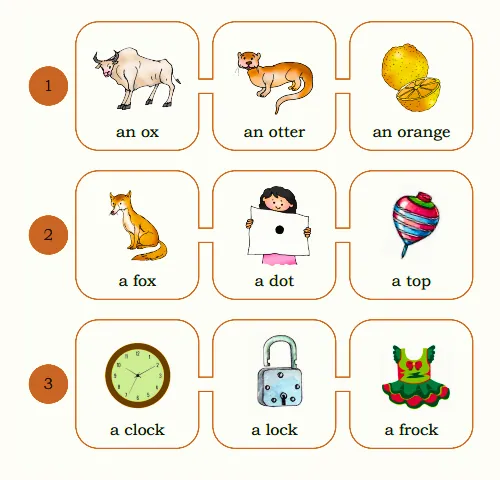Summary of Chapter 4: “Seeing without Seeing”
Curious Onshangla learns to ‘See’ the world in new ways in NCERT Class 2 English Chapter 4 – “Seeing without Seeing”. Her mother, Ava, introduces her to the concept of using touch, smell, and hearing to identify objects, helping her understand how people without sight experience the world. Through playful activities, Onshangla discovers the importance of empathy and respect for all individuals.
Seeing without Seeing Class 2 Questions and Answers
Let us Speak
1. Onshangla calls her ‘mother’ ‘Ava’. What is the word for mother in your mother tongue?
Answer: Mom, Maa, Amma
2. Close your eyes. Imagine that, when your eyes are closed, how would you identify the following: water, flower (any local flower), sugar, direction of a clapping sound.
Answer:
| Object | How to Identify (with Closed Eyes) |
|---|---|
| Water | Taste: Tasteless |
| Flower – Rose | Smell: Sweet and fragrant smell |
| Sugar | Taste: Sweet taste |
| Direction of clapping sound | Hearing: Identify direction based on intensity of sound reaching in each ear. |
Let us Draw
1. Draw two things which you like to smell.
Answer: Draw two of your favorite things to smell.
Not sure what to draw? Here are some examples: Rose flower, Basil plant, perfume etc.

2. Draw two things which you like to taste.
Answer: Draw two of your favorite things to taste.
Here are some examples: Mangoes, Chocolate cake,

Let us Write – Answer the following Questions
1. Fill in the blanks using suitable words from the boxes given below.

- Onshangla was very ___ one day.
- A new ___ came to Onshangla’s school.
- Ava placed ___ and ___ on the table.
- Ava played a new ___ with Onshangla.
- Onshangla cried, “Oh ! it is not water, it is ___ juice”.
Answer:
- Onshangla was very quiet one day.
- A new boy came to Onshangla’s school.
- Ava placed biscuits and milk on the table.
- Ava played a new game with Onshangla.
- Onshangla cried, “Oh! It is not water, it is orange juice”.
2. What activities do you like to do with your family members? Write about them. One has been given as an example.
Example: I like to walk with my grandfather.
- (a) I like to ___ with my ___.
- (b) I like to ___ with my ___.
Answer:
- (a) I like to read with my mother.
- (b) I like to play with my sister.
3. Write five things you can do by yourself. One example is provided for you.
Example: I can take a bath by myself.
Answer:
- I can brush my teeth by myself.
- I can dress up by myself.
- I can pack my school bag by myself.
- I can make my bed by myself.
- I can eat by myself.
Let us Do
Our eyes do so much for us. We should take care of them.
Put a ✓ for whatever is good for our eyes.
Put a ✗ for whatever is not good for our eyes.

Answer:
- Sit straight while reading or drawing. ✓
- Sit very close to the TV. ✗
- Stare at the sun. ✗
- Read in good light. ✓
- Eat carrots and lots of vegetables. ✓
- Play for a long time on the mobile. ✗
- Close eyes and splash water on eyelids. ✓
Read the words below each picture.

Also read: Chapter 3: It is Fun – NCERT Class 2 English Questions and Answers
Conclusion
The chapter “Seeing without Seeing” effectively teaches children about empathy, inclusion, and the importance of all our senses through a relatable story and engaging activities. It reinforces the importance of using all senses and appreciating the world from different perspectives, fostering compassion and understanding among young readers.
The story of Ava and Onshangla, where Onshangla identifies objects with a blindfold, highlights the power of senses beyond sight. This experience can spark curiosity in young learners and encourage them to be more mindful of their own senses. By understanding the challenges faced by people with visual impairments, children can develop greater empathy and inclusivity.
Complete NCERT Class 2 English Solutions
| NCERT Solutions | Unit-wise List | Chapter-wise Solutions |
|---|---|
| Unit 1: Fun with Friends | 1. My Bicycle Solutions 2. Picture Reading Solutions |
| Unit 2: Welcome to My World | 3. It Is Fun Solutions |
| Unit 3: Going Places | 5. Come Back Soon Solutions 6. Between Home and School Solutions 7. This is My Town Solutions |
| Unit 4: Life Around Us | 8. A Show of Clouds Solutions 9. My Name Solutions 10. The Crow Solutions 11. The Smart Monkey Solutions |
| Unit 5: Harmony | 12. Little Drops of Water Solutions 13. We Are All Indians Solutions |
Frequently Asked Questions – Seeing without Seeing
Ava and Onshangla played a game where Onshangla was blindfolded and had to identify objects using her other senses, such as touch, smell, and hearing.
Onshangla was quiet because she met a new boy in her class who couldn’t see, and she was thinking about how he would manage daily activities.
The story “Seeing without Seeing” teaches us that we can use our other senses, like touch, smell, and hearing, to understand the world around us, even if we can’t see. It encourages empathy and understanding for people with visual impairments, showing us that they can live full and meaningful lives.
